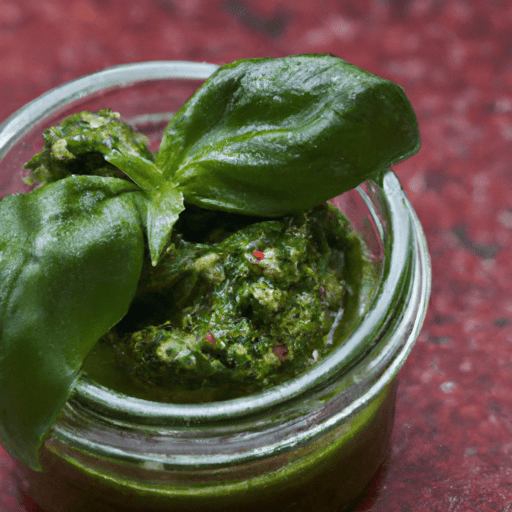All About Basil Pesto: A Classic Sauce with a Fresh Twist
If you’re a fan of Italian cuisine or simply love the vibrant flavors of fresh herbs, then you must try basil pesto. This iconic and versatile sauce is a true culinary gem that adds a burst of freshness to any dish it graces. In this blog post, we’ll dive into the world of basil pesto - exploring its delightful taste, common uses in cooking, nutritional value, and even uncovering some interesting history and facts behind this beloved sauce.
The Taste of Basil Pesto
Basil pesto is renowned for its unmistakable taste. It combines the earthy and aromatic flavors of fresh basil leaves with the richness of olive oil, the creaminess of pine nuts, the pungency of garlic, and the savory tang of Parmesan cheese. The result is a vibrant and well-balanced sauce that is both herbaceous and subtly nutty, with a hint of garlic and salty umami from the cheese. The incredible medley of flavors in basil pesto not only delights the taste buds but also leaves a refreshing and lingering herbal aroma.
Common Uses in Cooking
Basil pesto offers endless possibilities when it comes to culinary applications. Traditionally, it is used as a sauce for pasta, where it effortlessly coats each strand or noodle with its vibrant green hues and rich flavors. Simply toss cooked pasta with pesto, and you have a quick, delicious, and satisfying meal. However, its uses extend far beyond pasta.
Basil pesto is a fantastic spread for sandwiches and wraps, adding a pop of flavor and a touch of elegance to any lunch or picnic. It also serves as a versatile dipping sauce for bread, crackers, or raw vegetables. For those who fancy a gourmet pizza, substituting marinara sauce with basil pesto creates a wonderfully fresh and aromatic base.
Moreover, this vibrant sauce can be incorporated into countless recipes, such as marinades for chicken, fish, or vegetables. It can enhance the flavor of roasted or grilled meats and veggies, and even elevate the taste of soups, stews, and risottos. The possibilities are truly endless.
Nutritional Value
Apart from its incredible taste and versatility, basil pesto also boasts several health benefits. The main ingredient, basil, is rich in vitamins A, K, and C, as well as minerals such as magnesium, potassium, and iron. Basil is also renowned for its antioxidant and anti-inflammatory properties, making it a fantastic addition to any diet.
However, it’s worth mentioning that while basil pesto offers nutritional benefits, it is also relatively high in calories due to the olive oil, nuts, and cheese. Therefore, it’s recommended to consume it in moderation and balance it with other nutritious ingredients in your meals.
History and Interesting Facts
The origins of basil pesto can be traced back to the region of Liguria in Northern Italy, where it was first created. The word “pesto” is derived from the Italian verb “pestare,” meaning to pound or crush, referring to the traditional method of making the sauce using a mortar and pestle.
While the classic version of basil pesto includes basil leaves, pine nuts, garlic, Parmesan cheese, and olive oil, variations can be found throughout different regions and cuisines. Some recipes substitute pine nuts with other nuts like walnuts or pistachios, while others introduce additional herbs like parsley or mint. Each variation adds its own unique twist to this beloved sauce, allowing for countless creative adaptations.
Conclusion
Basil pesto is undoubtedly a culinary powerhouse that brightens up dishes with its fresh and aromatic flavors. Whether used to dress pasta, as a spread, or as an ingredient in various recipes, it never fails to impress. With its rich history, remarkable taste, and nutritional benefits, basil pesto remains a timeless favorite amongst food enthusiasts worldwide. So why not prepare a batch of homemade pesto and let your taste buds embark on a journey of vibrant and delicious flavors?
Origin: Basil pesto originated in the Liguria region of northern Italy. It is closely associated with Genoa, the capital city of Liguria.
Common Uses: Basil pesto is most commonly used as a sauce for pasta dishes, but it also serves as a spread for sandwiches, a topping for pizzas, or a condiment for salads. Additionally, it can be used as a flavoring agent in soups, stews, and marinades.
Nutritional Benefits: Basil pesto is nutrient-dense and offers several health benefits. It is a good source of vitamin K, which is necessary for blood clotting and bone health. It also contains vitamin A, which supports vision and immune function. Basil pesto is rich in essential minerals like calcium, iron, and magnesium. However, it should be consumed in moderation due to its high calorie and fat content.
Unique Properties: Basil pesto has a distinctive aromatic flavor, thanks to the combination of fresh basil leaves, garlic, pine nuts, Parmesan cheese, and olive oil. The vibrant green color of the sauce is attributed to the chlorophyll present in basil leaves. Traditionally, basil pesto is made by hand using a mortar and pestle to crush the ingredients together, preserving their flavors. Today, blenders or food processors are often used for convenience.
Historical Significance: The origins of basil pesto can be traced back to the ancient Roman period, where sauces similar to pesto were made using pounded herbs and additives. However, the modern version of basil pesto that we are familiar with today was standardized in the late 19th century by the cookbook author Giovanni Battista Ratto. Since then, it has become one of the most beloved sauces in Italian cuisine and gained worldwide popularity.




Use the share button below if you liked it.
It makes me smile, when I see it.